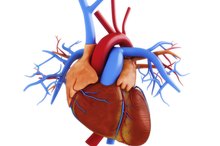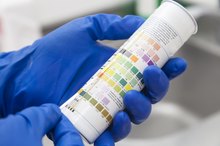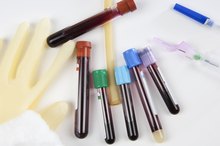What does fact checked mean?
At Healthfully, we strive to deliver objective content that is accurate and up-to-date. Our team periodically reviews articles in order to ensure content quality. The sources cited below consist of evidence from peer-reviewed journals, prominent medical organizations, academic associations, and government data.
The information contained on this site is for informational purposes only, and should not be used as a substitute for the advice of a professional health care provider. Please check with the appropriate physician regarding health questions and concerns. Although we strive to deliver accurate and up-to-date information, no guarantee to that effect is made.
What Is the BUN and Creatinine Ratio?
The BUN-to-creatinine ratio is a routine lab measurement used by your doctor to assess the function of your kidneys. It is calculated by dividing the serum BUN concentration by the serum creatinine concentration. Various conditions affecting your kidneys will alter this ratio in a predictable manner before you even show symptoms. Therefore, it is a useful ratio when monitoring subtle changes in your kidney health.
If you are experiencing serious medical symptoms, seek emergency treatment immediately.
Kidney Function
Your kidneys are capable of sustaining significant damage before showing any clinical symptoms, such as changes in urine volume or color. This is because kidneys are composed of an abundance of nephrons, which help produce urine. The number of nephrons you are born with is much greater than the number you need to survive. This creates a large buffer for kidney damage; therefore, while you may not be exhibiting any obvious symptoms, your kidneys may be under attack from an unknown disease process.
- Your kidneys are capable of sustaining significant damage before showing any clinical symptoms, such as changes in urine volume or color.
- This creates a large buffer for kidney damage; therefore, while you may not be exhibiting any obvious symptoms, your kidneys may be under attack from an unknown disease process.
BUN
Abnormal Blood Creatinine and BUN Levels
Learn More
BUN stands for Blood Urea Nitrogen. This molecule is a product of protein breakdown and is typically present in your blood at a stable concentration. Generally, the BUN concentration is related to your total muscle mass, as muscles are constantly undergoing breakdown and rebuilding processes, releasing nitrogen-rich protein into your blood. BUN is a waste product, but its excretion is not actively controlled. Its ability to permeate membranes allows us to use it as a measurement of the rate of urine flowing through nephrons.
- BUN stands for Blood Urea Nitrogen.
- Generally, the BUN concentration is related to your total muscle mass, as muscles are constantly undergoing breakdown and rebuilding processes, releasing nitrogen-rich protein into your blood.
Creatinine
Creatinine is also released into the blood by muscle, but its properties allow the kidney to handle it in a different way. Nephrons are capable of actively reabsorbing and secreting creatinine. By measuring the amount of cretinine in your blood, your doctor can assess how your kidneys are handling this unique molecule.
Different Ratios
Kidney's Function Related to the Circulatory System of the Human Body
Learn More
The ratio of BUN to creatinine in blood changes in a predictable way when different diseases affect the kidney. According to Mayo Clinic, variation in the BUN-to-creatinine ratio can often indicate to a physician not only that a kidney problem exists, but also approximately where the problem is located.
Applications
A normal BUN:creatinine ratio is 15:1, according to “Renal Pathophysiology.” When the ratio approaches 20:1, it suggests a problem with bloodflow to the kidney; this may be caused by conditions such as heart failure or shock 1. Alternatively, a BUN:creatinine ratio of 10:1 suggests an intrinsic renal disease, such as glomerulonephritis or acute tubular necrosis.
Related Articles
References
- "Renal Pathophysiology: The Essentials"; Helmut Rennke and Bradley Denker; 2007
- Gounden V, Jialal I. Renal Function Tests. In: StatPearls [Internet]. Treasure Island (FL): StatPearls Publishing; 2019 Jan-. Updated Apr 3, 2019.
- Gaitonde, D.; Cook, D.; and Rivera, I. Chronic Kidney Disease: Detection and Evaluation. Amer Fam Phys. 2017 Dec 15;96(12):776-783.
- Shimada, M, Dass, B, Ejaz AA. Evaluation of elevated creatinine. BMJ Best Practice. Updated November 2018.
- National Kidney Foundation. What is the Difference Between sCr, eGFR, ACR, and BUN?.
- U.S. National Library of Medicine. Creatinine clearance test. Updated September 11, 2019.
- National Institute of Diabetes and Digestive and Kidney Diseases. Albuminuria: Albumin in the Urine. Published October 2016.
- Cleveland Clinic. Blood Urea Nitrogen (BUN) Test. Updated January 10, 2018.
- National Kidney Foundation. Acute Kidney Injury: What Every Clinician Should Know. Published April 12, 2007.
- National Institute of Diabetes and Digestive and Kidney Diseases. Urinary Tract Imaging. Published May 2012.
- National Kidney Foundation. What is a Kidney Biopsy?.
- Ozmen, S.; Akin, D.; and Ozmen, C. A Review to Differentiate Acute Kidney Injury from Chronic Kidney Disease. BJMMR. 2016;18(9):1-7. doi:10.9734/BJMMR/2016/29879
- Selby, N.; Fluck, R.; Kolhe, N. et al. International Criteria for Acute Kidney Injury: Advantages and Remaining Challenges. PLoS Med. 2016;13(9): e1002122. DOI: 10.1371/journal.pmed.1002122. doi:https:10.1371/journal.pmed.1002122
Writer Bio
I have completed the first two years of medical school, during which time I have developed expertise in writing on medical and science topics for eHow and Livestrong. My blog, cAMPScience.org, has recently been approved at DMS for "Blogger" status, which will allow me to continue to develop my brand with this organization. I will provide high quality articles, using only the best sources in medical and science research.








